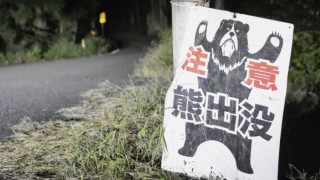Loading
Search
▼ Bears Spotted 13,670 Times In Japan In April-Sept., Most Since 2016
- Category:Other
Bears were spotted 13,670 times in the wild across Japan between April and September, the most for the six-month period since 2016, the Environment Ministry said Monday.
The tally was released following a recent spate of bear encounters by residents in Japan. Two women died in October as a result of bear attacks.
"The matter is drawing heightened public attention, and we need to work more closely to prevent harm," said Fumiko Nakao, chief of the ministry's wildlife section at a meeting of relevant government bodies, which also included the farm ministry and the National Police Agency.
At the meeting, the government entities reaffirmed their policy of encouraging local municipalities to raise alert levels against bears when needed, promoting measures to prevent encounters between bears and humans and sharing information on the animal's appearances, according to the Environment Ministry.
Nakao told reporters after the meeting that the number of bear sightings increased this summer, although it usually falls during the season. "The trend has been changing and we must keep our guard up as we head into the winter season," she said.
After a similar government meeting was held in September, bear attacks caused the death of the two women -- one in her 70s in Niigata Prefecture, northwest of Tokyo, and another in her 80s in Akita Prefecture in northeastern Japan.
Also in October, three bears were shot to death in Ishikawa Prefecture, central Japan. Two of them had attacked people and one had intruded into a commercial facility.
The prefectures are home to a population of Asian black bears -- the species of bear found on Japan's largest main island of Honshu -- while larger brown bears inhabit the country's northernmost main island of Hokkaido.
Worse than normal availability of wild tree nuts, particularly beech nuts, that make up a large part of the bears' diet in the mountains is believed to be why they are venturing closer to areas inhabited by humans in search of food ahead of their winter hibernation, experts say.
The tally was released following a recent spate of bear encounters by residents in Japan. Two women died in October as a result of bear attacks.
"The matter is drawing heightened public attention, and we need to work more closely to prevent harm," said Fumiko Nakao, chief of the ministry's wildlife section at a meeting of relevant government bodies, which also included the farm ministry and the National Police Agency.
At the meeting, the government entities reaffirmed their policy of encouraging local municipalities to raise alert levels against bears when needed, promoting measures to prevent encounters between bears and humans and sharing information on the animal's appearances, according to the Environment Ministry.
Nakao told reporters after the meeting that the number of bear sightings increased this summer, although it usually falls during the season. "The trend has been changing and we must keep our guard up as we head into the winter season," she said.
After a similar government meeting was held in September, bear attacks caused the death of the two women -- one in her 70s in Niigata Prefecture, northwest of Tokyo, and another in her 80s in Akita Prefecture in northeastern Japan.
Also in October, three bears were shot to death in Ishikawa Prefecture, central Japan. Two of them had attacked people and one had intruded into a commercial facility.
The prefectures are home to a population of Asian black bears -- the species of bear found on Japan's largest main island of Honshu -- while larger brown bears inhabit the country's northernmost main island of Hokkaido.
Worse than normal availability of wild tree nuts, particularly beech nuts, that make up a large part of the bears' diet in the mountains is believed to be why they are venturing closer to areas inhabited by humans in search of food ahead of their winter hibernation, experts say.
- October 26, 2020
- Comment (0)
- Trackback(0)


